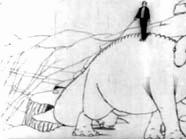Assigned Notebook Entry: Start by outlining the progress in animation technology made in this country up to 1920. Then I'd like you to go on and describe what you see as the relationship between art and technology in animated films. (Bring this to class, but you will not need to hand it in.)
In
reading this chapter, you're covering a lot of time and inventiveness, from
J. Stuart Blackton's Enchanted Drawing, which we'll be seeing in class,
to the rise of Felix the Cat in the 1920s. As you read, make of note of the
major names in the new field of animation, and start to develop a timeline of
the way in which these pioneers gradually developed the technology that would
allow cartoons to eventually become a mass medium.
One thing Maltin points out that you should keep in mind as you read is how new the medium of animation was and the variety of ways in which different artists worked within it.
Of particular interest to us in our class discussion are the films of:

In class, we'll look at a very unusual example of early cel animation, Windsor McCay's Sinking of the Lusitania, released in 1918 and intended as a powerful piece of propaganda to reinforce anti-German sentiment in the US during World War I. It's a far cry from Gertie and tries to take film animation into an entirely new direction, though, as you will observe, it was a road not taken. Time permitting, we'll also look at his first animation, Little Nemo, and his most famous creation, Gertie the Dinosaur.